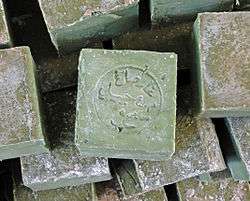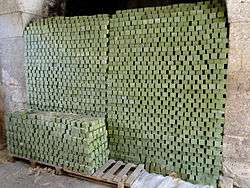Aleppo soap

Aleppo soap (also known as savon d'Alep, laurel soap, Syrian soap, or ghar soap, the Syrian word for 'laurel') is a handmade, hard bar soap.
Aleppo soap is classified as a Castile soap as it is a hard soap made from olive oil and lye, from which it is distinguished by the inclusion of laurel oil.
History
The origin of Aleppo soap is lost in time. Although claims of its great antiquity abound,[1][2] such as references in the popular press to Egyptian Queen Cleopatra and Queen Zenobia of Syria using Aleppo soap,[3][4] these claims have yet to be verified by Scholarly method.
It is commonly thought that the process of soap-making emanated from the Levant region (of which Aleppo is a main city) and to have moved west from there to Europe after the first crusades based on the claim that the earliest soap made in Europe was just after the crusades, but in fact the Romans in the first century AD knew about soap and Zosimos of Panopolis ca. 300 AD described soap and soapmaking.[5]
Today most Aleppo soap, especially that containing more than 16% of laurel oil, is exported to Europe and East Asia.[6]
Manufacturing process




Traditional Aleppo soap (Ghar) is made by the "hot process".
First, the olive oil is brought into a large, in-ground vat along with water and lye. Underneath the vat, there is an underground fire which heats the contents to a boil. Boiling lasts three days while the oil reacts with the lye and water to become a thick liquid soap.
The laurel oil is added at the end of the process, and after it is mixed in, the mix is taken from the vat and poured over a large sheet of waxed paper on the floor of the factory.
At this point the soap is a large, green, flat mass, and it is allowed to cool down and harden for about a day. While the soap is cooling, workers with planks of wood strapped to their feet walk over the soap to try to smooth out the batch and make it an even thickness.
The soap is then cut; three workers drag a rudimentary, rake-like cutting device through the soap to cut it one way, then again the other way until the whole mass is cut into individual cubes. Each cube is stamped with the soap artisan's name.
The cubes of soap are then stacked in staggered cylinders to allow maximum air exposure. Once they have dried sufficiently, they are put into a special subterranean chamber to be aged for six months to a year.
While it is aging, the soap goes through several chemical changes. First, and most importantly, the free alkaline content of the soap (the alkaline which did not react with the oil during saponification) breaks down upon slow reaction with air. The moisture content of the soap is also reduced, making the soap hard and long lasting. And lastly, the color of the outside of the soap turns a pale gold, while the inside remains green.
Modern Aleppo soaps are manufactured using a "cold process" and contain olive and laurel oils, and may contain a variety of herbs and/or essential oils.
Ingredients
Traditional Aleppo soap is made with 100% natural, olive and laurel berry oils, water and lye.
The relative concentration of laurel oil (typically from 2–30%) determines the quality and cost of the soap.
In the 20th century, with the introduction of cold process soap making, Allepian soap artisans began introducing a variety of herbs and essential oils to their soaps.
Skin care properties
Aleppo soap can be used daily as soap for washing and shampooing, as face mask, as shaving cream, and for bathing infants and babies.[7]
The soap is effective against insect bites[8] and is used for a variety of skin ailments such as skin allergies, irritated skin or conditions such as general dermatitis like eczema, psoriasis, bacterial dermatitis, acne, herpes, rosacea, it also helps prevent hair loss and it aids in the recovery of skin diseases.[9]
Laurel oil is an effective cleanser, antibiotic,[10] anti-fungal[11] and anti-itching agent. Compounds extracted from Laurus Nobilis have recently been identified as an inhibitor of human melanoma (skin cancer) cell proliferation,[12] as well as inhibiting other human tumor cell growths such as amelanotic melanoma, renal cell adenocarcinoma, and breast cancer cell lines.[13]
Olive oil has been known for generations not only for its healing qualities but also as a natural, deep penetration moisturizer, regenerating skin cells and softening the tissue.[14]
Unlike most soaps, Aleppo soap will float in water.
Environmental facts
Aleppo soap is made from natural oils derived from the fruits of olive and laurel trees and is biodegradable.[15]
Laurus nobilis is categorized as an Underutilized Species.[16][17]
See also
References
- ↑ Mosquin, Daniel (2008-03-26). "Laurus nobilis - Botany Photo of the Day". Botanicalgarden.ubc.ca. Retrieved 2012-07-09.
- ↑ "Aleppo Soap, The True Natural Soap". Natural Cosmetic News. Retrieved 2012-07-09.
- ↑ "'So tell me about your massage' | Middle East". Times Online. 2012-03-13. Retrieved 2012-07-09.
- ↑ needing more detailed references%5d%5d Developing markets for ... - Alessandra Giuliani, Bioversity International - Google Books Check
|url=value (help). Books.google.ca. 2007-10-30. Retrieved 2012-07-09. - ↑ Partington, James R partington (1960). "A history of Greek fire and gunpowder": 307.
- ↑ Yacoub, Khaled (2010-10-22). "Modern threat to Syria's ancient Aleppo soap industry". Reuters. Retrieved 2012-07-09.
- ↑ Kiechl-Kohlendorfer, Ursula; Berger, Cindy; Inzinger, Romy (2008). "The Effect of Daily Treatment with an Olive Oil/Lanolin Emollient on Skin Integrity in Preterm Infants: A Randomized Controlled Trial". Pediatric Dermatology. 25 (2): 174–8. doi:10.1111/j.1525-1470.2008.00627.x. PMID 18429773.
- ↑ Erler, F; Ulug, I; Yalcinkaya, B (2006). "Repellent activity of five essential oils against Culex pipiens". Fitoterapia. 77 (7–8): 491–4. doi:10.1016/j.fitote.2006.05.028. PMID 16890387.
- ↑ Aleppo Soap, The True Natural Soap | Natural Cosmetic News from Natural Cosmetic News - Natural Blog for the Cosmetic and Personal Care Industry. Retrieved July 2011.
- ↑ Fukuyama, Noriaki; Ino, Chieko; Suzuki, Yumiko; Kobayashi, Noritada; Hamamoto, Hiroshi; Sekimizu, Kazuhisa; Orihara, Yutaka (2011). "Antimicrobial sesquiterpenoids fromLaurus nobilisL". Natural Product Research. 25 (14): 1295–303. doi:10.1080/14786419.2010.502532. PMID 21678158.
- ↑ Simić, A.; Soković, M. D.; Ristić, M.; Grujić-Jovanović, S.; Vukojević, J.; Marin, P. D. (2004). "The chemical composition of some Lauraceae essential oils and their antifungal activities". Phytotherapy Research. 18 (9): 713–7. doi:10.1002/ptr.1516. PMID 15478207.
- ↑ Panza, Elisabetta; Tersigni, Mariaroberta; Iorizzi, Maria; Zollo, Franco; De Marino, Simona; Festa, Carmen; Napolitano, Maria; Castello, Giuseppe; et al. (2011). "Lauroside B, a Megastigmane Glycoside fromLaurus Nobilis(Bay Laurel) Leaves, Induces Apoptosis in Human Melanoma Cell Lines by Inhibiting NF-κB Activation". Journal of Natural Products. 74 (2): 228–33. doi:10.1021/np100688g. PMID 21188975.
- ↑ Loizzo, MR; Tundis, R; Menichini, F; Saab, AM; Statti, GA; Menichini, F (2007). "Cytotoxic activity of essential oils from labiatae and lauraceae families against in vitro human tumor models". Anticancer research. 27 (5A): 3293–9. PMID 17970073.
- ↑ O'Meagher, Gillian. The West Australian (Perth), March 22, 2011 Tuesday, BOD; Pg. 4.
- ↑ Al-Darbi, M.M.; Saeed, N.O.; Islam, M.R.; Lee, K. taylor_francis (2003). "Biodegradation of Natural Oils in Seawater": 21.
- ↑ "Laurel (Laurus nobilis)" (PDF). Global Facilitation Unit for Underutilized Species. Retrieved 2014-01-05.
- ↑ Gruere, Guillaume; Smale, Melinda; Giuliani, Alessandra AgEcon (2006). "Marketing Underutilized Plant Species for the Poor": 2.
Bibliography
- Anna Lindh Foundation EUROMED (2008). "Sustainable Agriculture - Olive Oil Policy Analysis 1:1. The History Of Olive Oil": 2.
- Nayak, Shivananda; Nalabothu, Poorna; Sandiford, Steve; Bhogadi, Vidyasagar; Adogwa, Andrew (2006). "Evaluation of wound healing activity of Allamanda cathartica. L. And Laurus nobilis. L. Extracts on rats". BMC Complementary and Alternative Medicine. 6: 12. doi:10.1186/1472-6882-6-12. PMC 1456996
 . PMID 16597335.
. PMID 16597335.
External links
| Wikimedia Commons has media related to Aleppo soap. |
- Arthur, Golda. Aleppo soap: War threatens an ancient tradition BBC News, 15 May 2013.